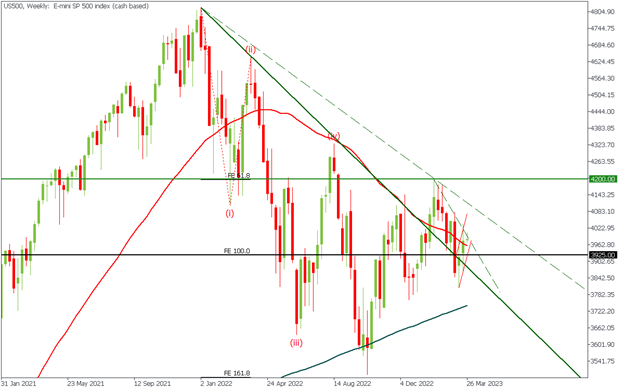As we realize that the US inflation is far from temporary, the market is reversing. How deep can US stock indices fall, and which sectors could be a safe haven in a global reversal?
Robust labor market data and stable inflation leave the Fed no choice.
Since the beginning of this year, US stock markets have ignored any reversal signals. Most market sectors were rising. Meanwhile, markets should have paid attention to the inflation data in the first place. The US CPI released on February 14 showed a gain of 0.5% for January and +6.4% YoY with an expected growth of 6.2%.
Of course, it was much worse in the middle of last year, when inflation exceeded the 7-8% mark, but the critical factor here is still the stability of inflationary processes. To remind you, the Fed targets the 2% inflation level. The nature of inflationary processes has also changed. The sharp spike in CPI last year was primarily due to a sharp increase in energy prices and, as a consequence, the rise in the cost of supply chains (supply inflation).

This year, the energy and food inflation is slowing, while at the same time, the service and rental inflations continue to rise. We can talk about an increasing inflation shift toward demand. If so, the Fed's actions in tightening monetary policy are justified. The latest inflation figure is 6% - still quite a lot.
Despite SVB and Silvergate banks’ collapse, the Fed hiked the rate to 5% and promised to raise the rate once more this year. Next year the Central bank promises to start monetary easing by reducing the rate by 75 bp. Extraordinary, but the market doesn’t believe Powell. Moreover, by the end of this year, the market expects the rate to be 3.75% - 4%.
It seems that the markets managed to forget two main things completely:
- The effect of a rate hike is always delayed.
- The Fed has not indicated any further prospects for monetary easing. At least not for this year.
The labor market data, one of the key triggers for the regulator, also gives no reason to pause – the unemployment rate in February is extremely low ( 3.6%).
Have the markets started to turn around?
Without verbal interventions from the FOMC representatives confirming the change in the Fed's chosen course, the markets started to suspect something. The Dow Jones Industrial Average is down 3.4% in February, the Nasdaq 100 is fluctuating in the range of 12100 points, and the broad market index S&P 500 has once again moved below the significant level at 4100.
|
Sector |
Returns in February 2023 |
|
Communication Services |
-4.92% |
|
Consumer Staples |
-1.75% |
|
Consumer Discretionary |
-2.21% |
|
IT |
0.48% |
|
Real Estate |
-6.70% |
|
Materials |
-3.92% |
|
Financials |
-2.61% |
|
Industrials |
-0.92% |
|
Health Care |
-4.02% |
|
Utilities |
-4.72% |
|
Energy |
-6.26% |
The strongest drawdown is observed in the real estate sector, which is also an alarm bell for the American economy. Also, we can assume a correction in the energy sector (last year, the energy sector grew by more than 50%).
The information technologies sector is still the leader. It’s not surprising that the information Technologies sector is still the leader since it includes, for example, NVIDIA (NASDAQ:NVDA) with significantly increased capitalization due to the good reporting published on February 22, and Microsoft (NASDAQ:MSFT) with the incredibly popular ChatGPT.
The chances that the S&P 500 will continue to decline are pretty high. But where is the bottom, and which market sectors will do better than the others?
S&P 500 Technical Analysis
In case the S&P falls further, one of the movement scenarios will be forming of a full-fledged Elliott ZigZag correction wave. If the scenario is correct, we have at least five more waves of decline ahead.
The best-case scenario is that the target range for the S&P 500 is between 3400 and 3500 points, and the worst-case scenario is that the index may fall below 3000 points. However, this will only happen if the Fed continues to be as aggressive as possible.
We recommend not writing off the energy sector because amid the opening of China and the renewed demand for energy, the oil price may test $100 per barrel again, and hence the shares of energy companies may resume their growth. If so, Marathon Oil (NYSE:MRO) stock, which is undervalued by multiples and DCF analysis, may become one of the market leaders.
Do not forget about the IT sector. In the near term, companies will try to catch up with Microsoft, and the race in AI will begin. Google (NASDAQ:GOOGL), Apple (NASDAQ:AAPL), and Amazon (NASDAQ:AMZN) could be in focus here. Although the market is ready to collapse, investors may still find some good ideas for their portfolios.
***
FBS is an international brand present in over 150 countries. Independent companies united by the FBS brand are devoted to their clients and offer them opportunities to trade Margin FX and CFDs.
FBS Markets Inc. – license IFSC/000102/310
Tradestone Ltd. – CySEC license number 331/17, FCA temporary permit 808276
Intelligent Financial Markets Pty Ltd – ASIC Licence number 426359
